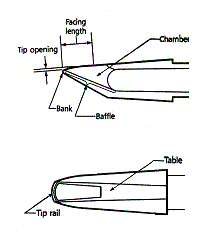Introduction
Materials
Design
Mouthpiece Faults
Selecting a Mouthpiece
Although often neglected, the mouthpiece is just as important as the quality of the reed in determining sound production on single reed instruments. In fact, unlike the brasses, the intonation and blend of a clarinet or saxophone section will often improve significantly when players use similar mouthpieces.
Clarinet and saxophone mouthpieces are usually made of hard rod rubber. It plays easily, has strong fundamentals and more overtones than mouthpieces made of plastic or wood. Metal mouthpieces are also acceptable for the saxophone, particularly since the strength of the material makes it possible to reduce the exterior proportions to the point where very young players do not feel that the mouthpiece is excessively large. Jazz players (notably tenor saxophonists) often prefer metal mouthpieces, arguing that they aid in creating a brighter, more authentic jazz sound. Classical players, however, hold to the belief that hard rubber mouthpieces produce a superior tone quality. There is general agreement, however, that mouthpieces made of moulded rubber or plastic should be avoided. The latter, which often have shiny surfaces, tend to warp easily. Softer materials produce a darker tone and more flexible response, but also tend to lose their shape more easily.
Various aspects of mouthpiece design also affect the instrument’s response. The lay, or curved area at the top of the mouthpiece (sometimes called the facing), determines the size of the opening between the reed and the mouthpiece tip. A short lay or facing produces a smaller tip opening, while a long lay results in a larger tip opening. The longer lay requires a firmer embouchure and a softer reed. It produces a dark tone, but can make the instrument difficult to play loudly.
Interestingly, differently designed lays - whether the curve is smooth and even or simply straight, for example - can make reed appear soft on one mouthpiece and hard on another.
The placement of the reed on the mouthpiece is also important. The tip of the reed should be aligned both with the rails and with the tip of the mouthpiece. Only a hint of the mouthpiece should be visible above the reed. An incorrectly placed reed can be cause intonation problems (too flat or too sharp), poor tone (too breathy or too thin) and unwanted squeaks.
 Other mouthpiece design factors influencing the instrument’s response include the size of the window and throat and the shape of the baffle. In fact, the shape of the baffle and the inner chamber influences the tone quality of a mouthpiece more than the material from which it is made. A concave baffle gives a softer sound and requires more air, making the sound more difficult to produce. A convex baffle, on the other hand, gives a louder sound and requires less air, but makes the sound more difficult to control.
Other mouthpiece design factors influencing the instrument’s response include the size of the window and throat and the shape of the baffle. In fact, the shape of the baffle and the inner chamber influences the tone quality of a mouthpiece more than the material from which it is made. A concave baffle gives a softer sound and requires more air, making the sound more difficult to produce. A convex baffle, on the other hand, gives a louder sound and requires less air, but makes the sound more difficult to control.
The window is the opening at the top of the mouthpiece. Large openings produce dark tones whereas narrow ones produce brighter and more penetrating ones. Similarly, the more curved the upper area of the mouthpiece interior and the more open the throat, the darker and (in extreme cases) more unfocussed the tone.
A number of common playing difficulties can be traced to mouthpiece faults, including squeaks, hard blowing and rough tone. The following are among the most common:
Excessive Squeaks may be due to:
|
|
|
|
|
|
|
|
|
|
|
|
|
Hard blowing may be due to:
|
|
|
|
|
|
|
|
|
Rough tone may be due to:
|
|
|
|
|
|
|
The catalogues of most woodwind mouthpiece manufacturers such as Yamaha and Leblanc distinguish between mouthpiece models in terms of materials used (metal, plastic, hard rod rubber or ebonite), tip opening, and the lay or facing length, the latter measurements being given in millimetres.
Eugene Rousseau ["Saxophone Mouthpieces" in Bandworld vol. 7 No. 4 March/April 1992] gives the following tips for those choosing a saxophone mouthpiece. Much of the advice, however, can also be applied to selecting a clarinet mouthpiece.
|
|
|
|
|
|
|
|
|












